The Windows operating system has many caches that are stored on your secondary storage. Though the amount of these individual cached files and temporary files are typically very less, when put together they can occupy a pretty significant chunk of your storage.
For the uninitiated, a cache is nothing but a group of temporary files that are stored on your computer to provide you faster access to the most used programs and websites. These files accumulate over time as you keep using your computer and is a good practice to remove them from time to time.
Moreover, there are many types of caches that you might want to clear from your Windows 11 PC, namely, RAM cache, location cache, Microsoft Store cache, browser cache, and DNS cache. Since all of this cache requires a separate process to clear, we are going to showcase all of these for your ease of convenience.
To add to that, in Windows 11 you can also use Storage Sense, to clear selected cache and temporary files from your computer periodically and lift this hassle off your shoulder. However, before you jump on to clear all the temporary files from your system, getting acquainted with them cannot hurt.
Categories of Temporary Files Present on your System
Since there are many categories of temporary files that hog your precious storage, it is imperative that you understand the file types and their usage so you can take an informed decision on what to delete and what to keep.
- Temporary Files: These kinds of files are accumulated by using apps on your system that are stored to provide a faster launch of the app and a better user experience. These files are completely safe to delete and will not impact your account data and/or your personal information.
- Temporary Internet Files: These cache files are usually cookies that contain but are not limited to your website preferences, advertising tracking identification, and website data that helps you load frequently used websites faster. Though similar to temporary files, this category is safe to delete, however, this might impact the loading speed of some websites.
- Delivery Optimization Files: This category of files are stored in a dedicated cache and are used to download the upgrades from the Microsoft server and then push them to all locally available Windows devices from a master PC to reduce cellular usage and bandwidth hogging. In case you do not intend to use this feature or you do not have more than one Windows device, you can safely delete files present under this category.
- Temporary Windows Installation Files: These are just installation files that have been used at the time of setup of the operating system on your device. These files no longer serve a purpose and can be deleted from your system without any impact.
- Previous Windows Installation File(s): As the name suggests these files are from the previous installation of Windows on your device. This category will only exist if you have upgraded from one iteration of Windows to another. These files mainly comprise data that might conflict at the time of installation and can be accessed from your Windows installer drive. That being said, you can safely delete these files from your computer.
- Windows Error Reports & Diagnostics Files: These files are generated from all the errors faced by you during using the system which is then sent to Microsoft to improve the reliability of the operating system and identify various issues. Typically since these are only text files, they will not have a large file size. However, if the size is significant and you are running out of memory on your system, you can delete these files.
- Microsoft Defender Antivirus: As the name suggests, these are supporting files for the Microsoft Defender; however, you can safely delete these files from your system as they will not impact the functionality of the Defender nor would it compromise the security of your PC.
- Thumbnails: These files help load the thumbnails of all the apps, files, and folders on your system faster. Typically, it should have a very minimal storage footprint; however, in case the files are occupying significant storage, you can safely delete them as Windows will automatically create new thumbnails for the currently present items on your computer.
- DirectX Shader Cache: These files are used to speed up graphics-intensive apps and improve their responsiveness. Similar to thumbnails, they too should occupy modest storage space. In case the files are large enough, you can delete them without having an impact on your PC as they will be regenerated if and when needed.
1. Run Disk Cleanup on your System
Disk Cleanup is a built-in Windows tool that helps you remove unnecessary files from your system. Though the tool has been present in the operating system for a long time; only in the latest iteration of Windows, Microsoft has changed the way to access it.
To run the Disk Cleanup on your device, first, head to the Start Menu and type Disk Cleanup to perform a search for it. Then, from the search results, click on the ‘Disk Cleanup’ tile to open the app on the device.

Alternatively, you can also initiate the Disk Cleanup wizard using the Run utility. To do so, press the Windows+R keys together on your keyboard to bring up the Run utility. Then, type cleanmgr in the text box and hit Enter on your keyboard to open Disk Cleanup.
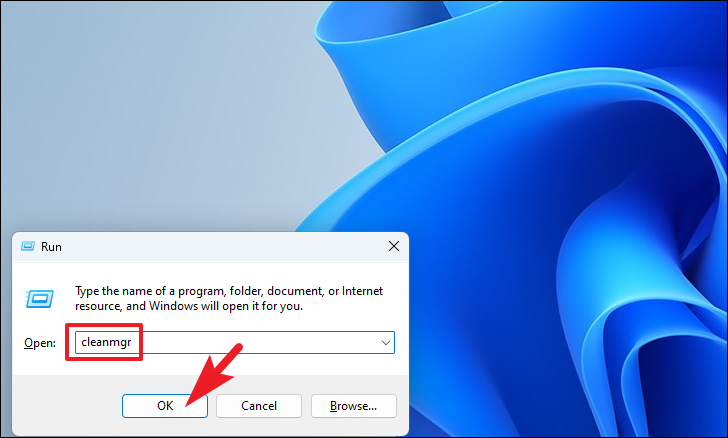
After that, on the Disk Clean up wizard window, click on the drop-down menu to reveal the list of all the storage drives. Then, click to select one of the drives you wish to run the Disk Cleanup on. Next, click on the ‘OK’ button to let Windows compute all the files that can be cleaned up.
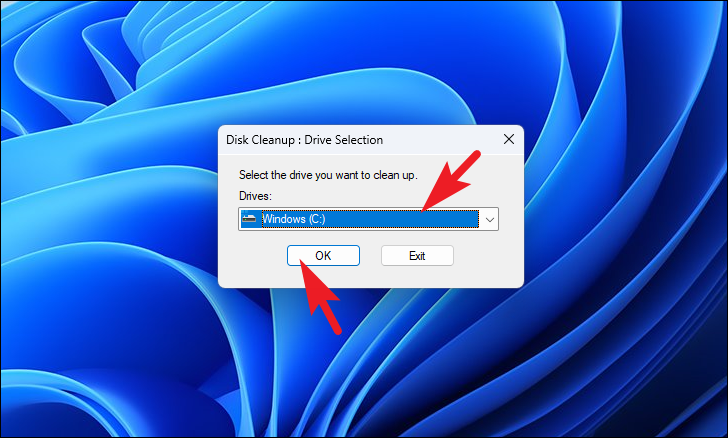
Once computed, another disk cleanup window will open on your screen. By default, some categories of the files would be already selected; you can now scroll the list to view all the files that can be cleaned up and select an individual category by clicking on the checkbox preceding each category.
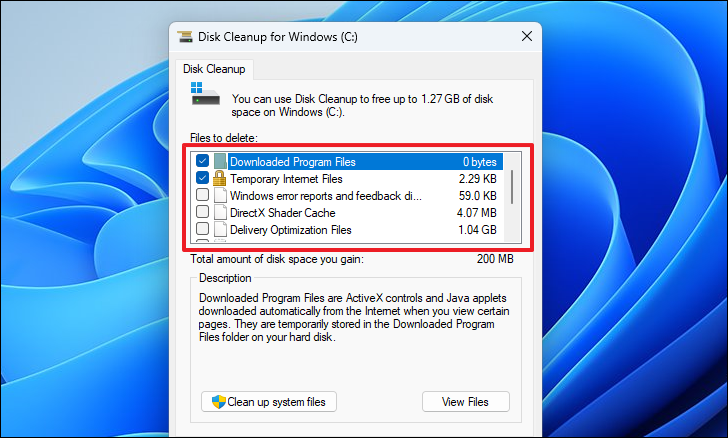
The Disk Cleanup wizard will also display the amount of disk space occupied by each file category on the screen. Along with that as you select multiple categories, you will also be notified of the total amount of space you will be cleaning up by deleting the files.
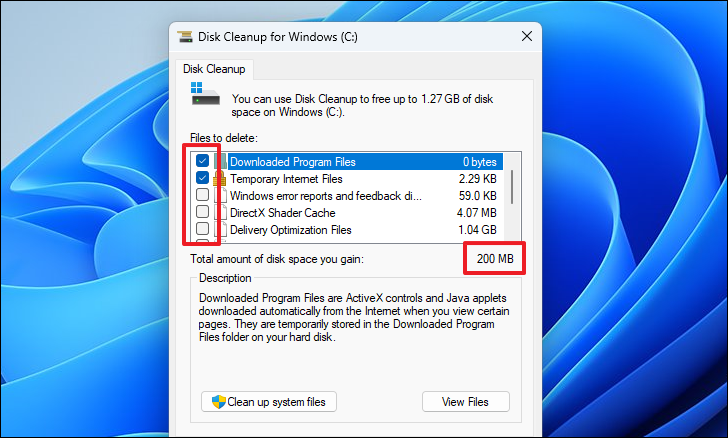
Once you have selected your preferred category of files to delete, click on the ‘OK’ button to proceed. This will bring up an overlay prompt on your screen.
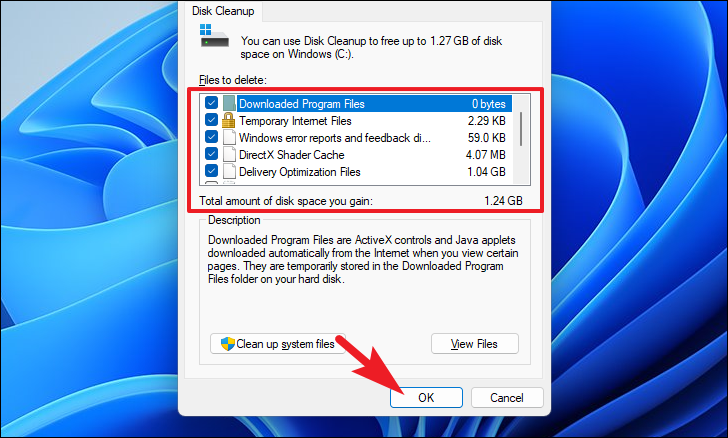
Next, click on the ‘Delete Files’ button to remove all the selected categories of files from your computer.
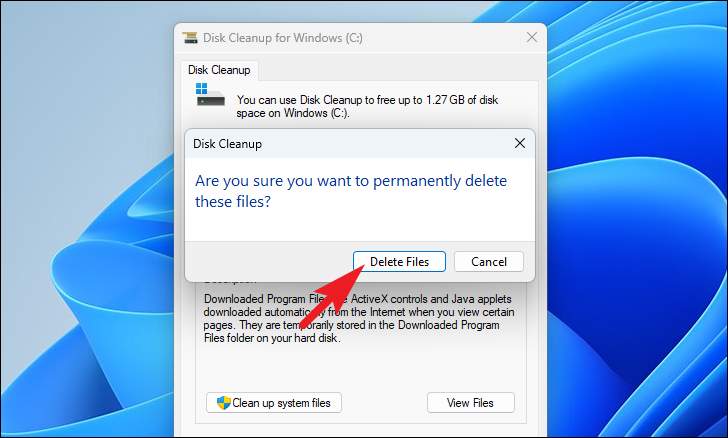
And that’s it you have successfully removed all the unnecessary files from your system using the Disk Cleanup.
2. Free Up Space by Using Clean Up Recommendations
Now, as mentioned earlier, Disk Cleanup has been a part of windows for ages, hence the user experience of the same feels a bit ancient and out of the place for users who have recently shifted to the Windows platform. Hence, they can also clear up some space on their computer using the Clean up recommendations which offers a much better experience along with more convenience.
To clear up space using this method, first, head to the Start Menu and click on the ‘Settings’ tile present under the ‘Pinned apps’ section to continue. Otherwise, type ‘Settings’ in the menu to perform a search for it. Alternatively, you can also press the Windows+I keys together on your keyboard to open the app.
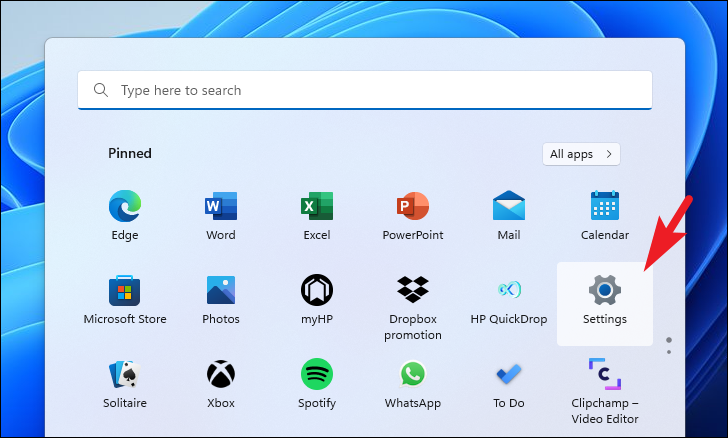
Now, on the Settings window, make sure you have selected the ‘System’ tab present on the left sidebar to continue.

Next, from the right section of the window, scroll down to locate and click on the ‘Storage’ tile to proceed.
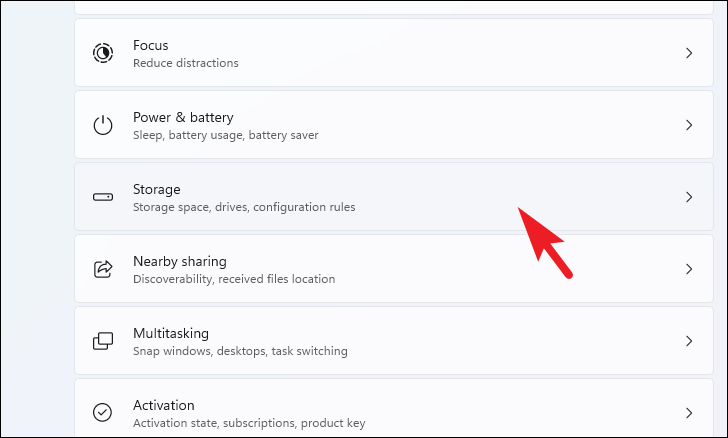
After that, from the ‘Storage’ settings page, scroll down to locate and click on the ‘Cleanup recommendations’ tile present under the ‘Storage Management’ section of the page to continue.
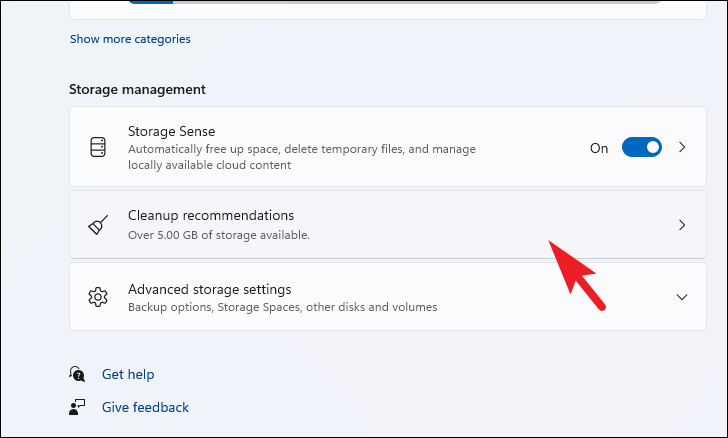
Now, on the ‘Cleanup recommendations’ page, first, click on the ‘Temporary files’ tile to expand the section. Then, select the categories of files by clicking on the checkbox preceding each listing. In case you wish to select more categories of temporary files, click on the ‘See advanced options’ button. Once you have selected your preferred categories, click on the ‘Clean up’ button present at the end of the section to clean up selected files and free up memory on your Windows 11 device.

Similarly, click on the ‘Large & unused files’ tile to expand the section. All your unused and very large files will be listed in the section. Review each folder and select it by clicking on the checkbox preceding each list item.
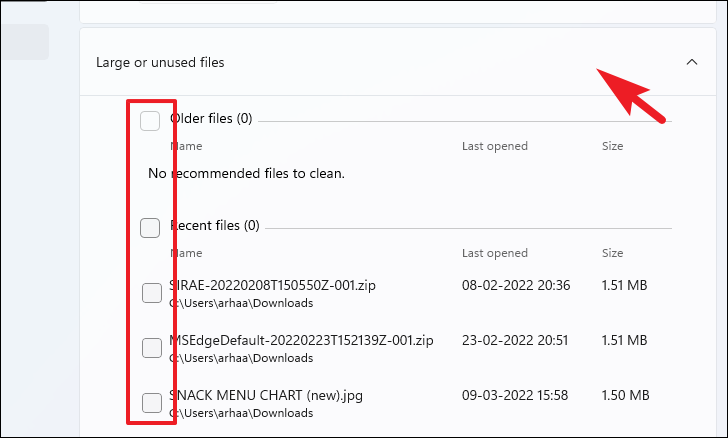
If you wish to expand the list of files that you can remove to free up the space on your computer, click on the ‘See more files’ option. Once you have selected the required files, click on the ‘Clean up’ button to delete those files permanently from your system.
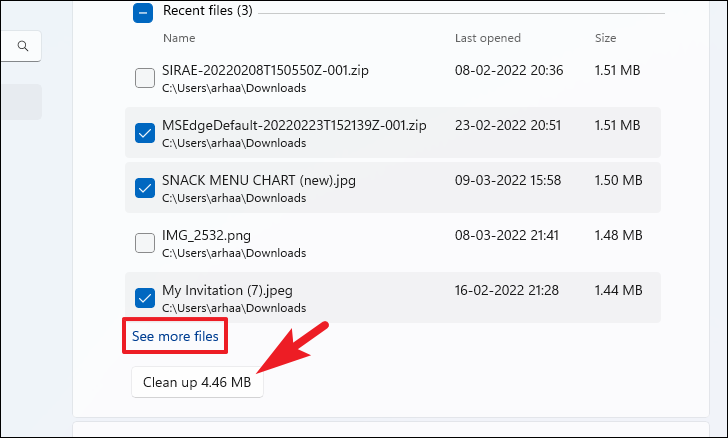
After that, click on the ‘Unused apps’ tile to expand the section. Next, if there are any apps present in the list select them by clicking on the checkbox preceding each item and then click on the ‘Clean up’ button to remove those apps and their data from your system.
3. Empty the Temporary Files Folder
Though Disk Cleanup and Cleanup Recommendation are very efficient ways to clean up almost all the temporary files present on the system, except the ‘Temp’ folder that is present in your Windows installer drive. The files get accumulated over time in this directory as you use your PC. That being said, you can safely remove these files as they will be re-generated as and when required.
To empty the temporary folder on your device, first, press the Windows+R keys together on your keyboard to bring up the Run command utility on your screen. Then, type %temp% and either hit Enter on your keyboard or click on the ‘OK’ button to proceed. This will open a separate File Explorer window on your screen.
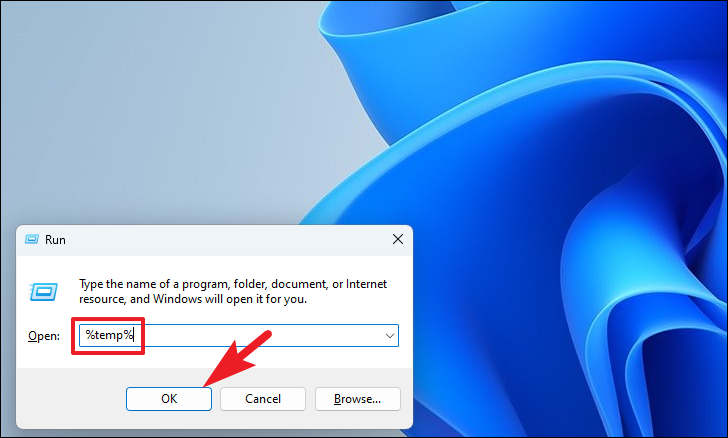
After that, on the ‘Temp’ folder directory, press the Ctrl+A keys together on your keyboard to select all the files, and then press the Shift+Delete keys together on your keyboard to delete all the selected files. You will receive a prompt on your screen for the confirmation of the action, click on the ‘Yes’ button to commence deletion of all files.
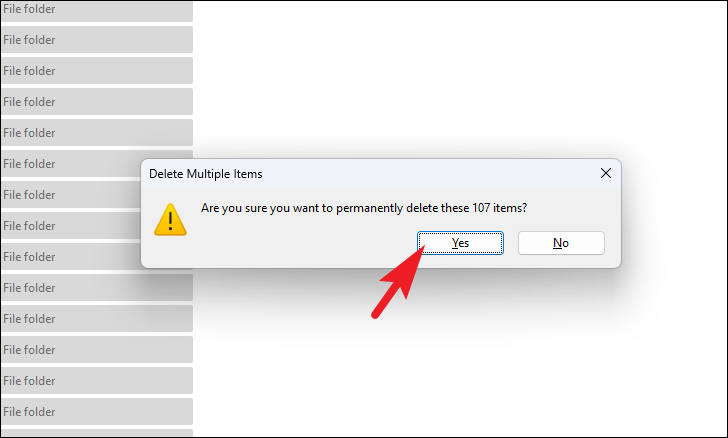
You might receive a prompt saying some files cannot be deleted as they are currently in use, that is perfectly fine as there might be some background services or apps using them. Now, click on the checkbox preceding the ‘Do this for all current items’ and click on the ‘Skip’ button to leave the files as-is.

4. Clear Browser Cache
Over time as you keep visiting websites, the browser accumulates some files like thumbnails, icons, images, and time codes as well to enable a faster browsing experience. Though it is generally not recommended to clean up browser cache. however, if you are really running low on storage, or if you are facing issues loading some websites lately, clearing the cache is one of the most effective ways to tackle those issues. For your ease of convenience, we will be showcasing the process to clear cache from all the popular browsers.
Clearing Cache in Microsoft Edge
Clearing cache from the default browser of your device is a very simple and easy process once you get a hang of it. In fact, the process literally takes only a couple of clicks from your side.
To do so, first, head to the Start Menu and click on the ‘Edge’ icon tile present under the ‘Pinned apps’ section to continue. Otherwise, type ‘Edge’ in the menu to perform a search for it.
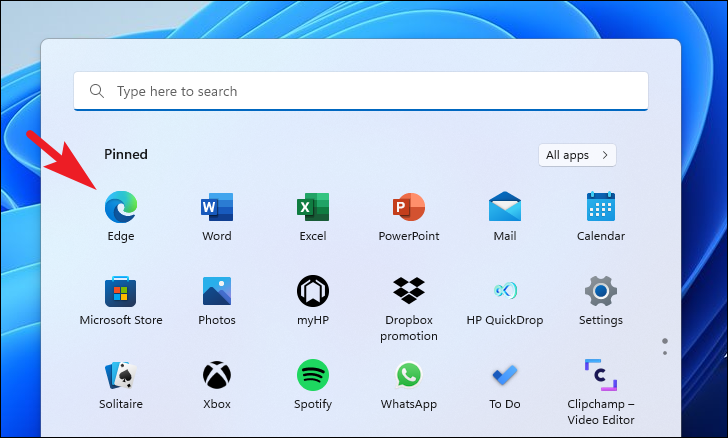
After that, on the Edge window, press the Ctrl+H keys together on your keyboard. This will bring a flyout menu to your screen. Now, click on the ‘ellipsis’ icon present in the top right corner of the flyout menu and click on the ‘Clear browsing data’ option present on the overflow menu to continue. This will open a separate tab in Microsoft Edge.
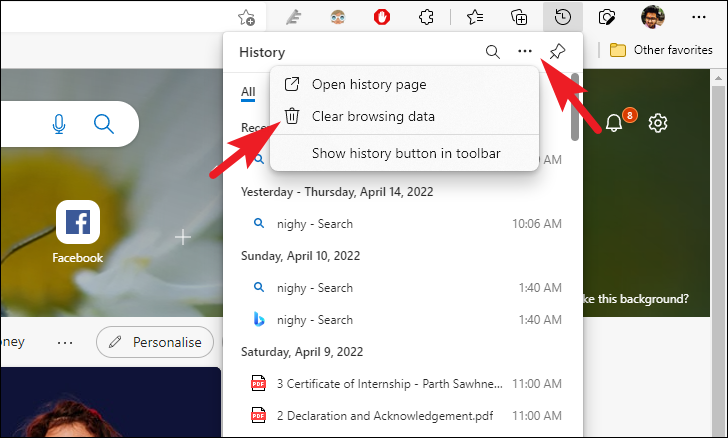
Next, from the separately opened tab, first, click on the dropdown menu present at the top section of the window and select the ‘All time’ option from it, Then, deselect all the options except the ‘Cached images and files’ option by clicking on the checkbox preceding each option. Once done, click on the ‘Clear now’ button present on the overlay window to clear the browser cache.
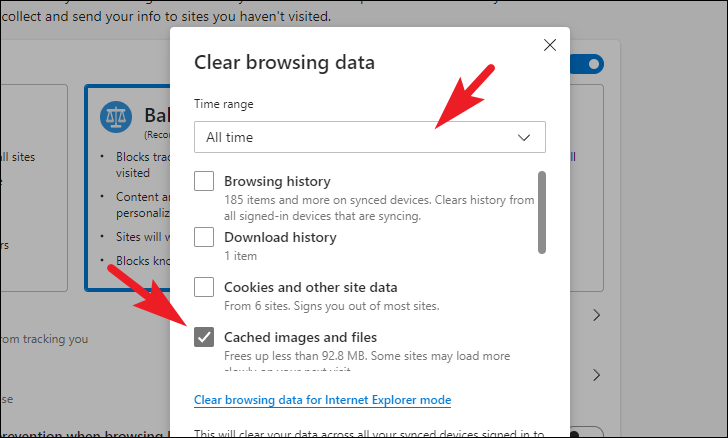
And that’s it you have successfully cleared cache on Microsoft Edge.
Clearing Cache in Google Chrome
Clearing cache from Google Chrome is a similar process to that of Microsoft Edge, however, there are a couple of extra steps to do so.
To clear the cache from Google Chrome, first, head to the Start Menu and type Chrome in the menu to perform a search for it. Then, from the search results, click on the ‘Google Chrome’ tile to open the app.
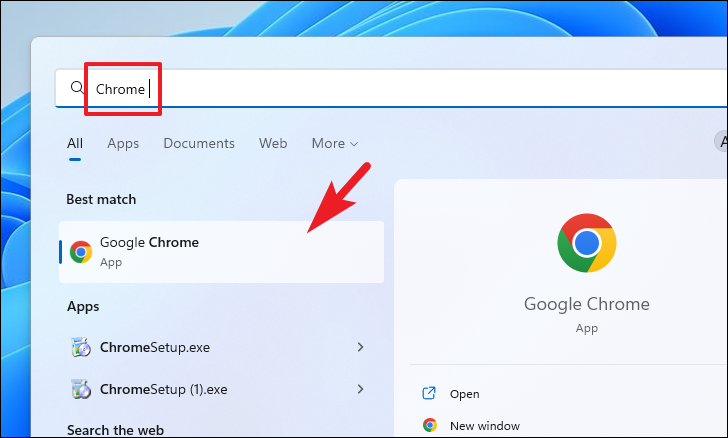
After that, on the Chrome window, click on the ‘ellipsis’ icon present in the top-right section to reveal the overflow menu. Then, locate and click on the ‘Settings’ option from the menu to proceed. This will open a separate tab in the Chrome window.
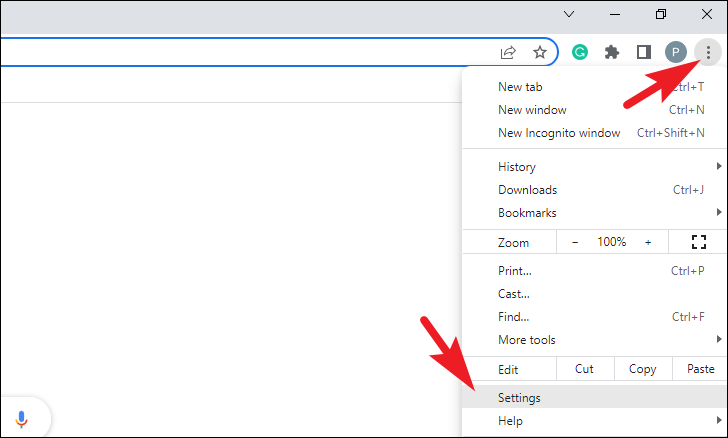
Now, on the ‘Settings’ tab on the Chrome browser, click on the ‘Privacy and security’ tab present in the left sidebar of the page to continue.
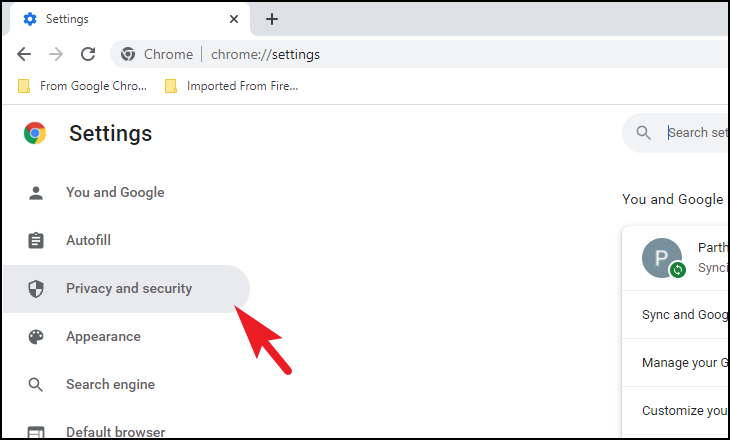
Then, from the right section of the webpage, click on the ‘Clear browsing data’ tile to proceed. This will bring an overlay window to your screen.
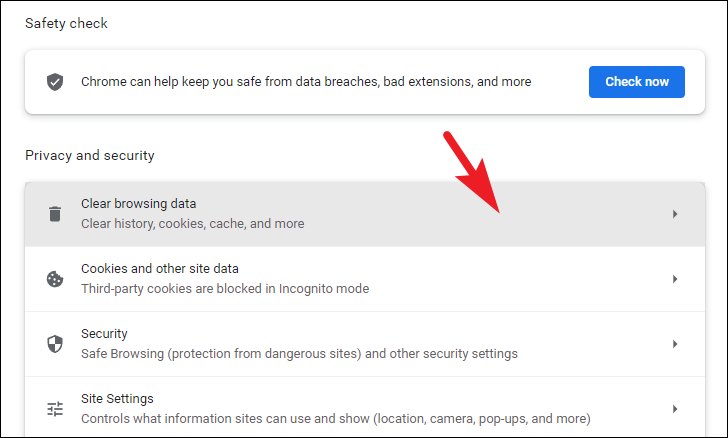
Now, from the overlay window on your screen, deselect all the options except the ‘Cached images and files’ option by clicking on the individual checkbox preceding each list item. Once done, click on the ‘Clear Data’ button present in the bottom right corner of the window to proceed and clear the data.
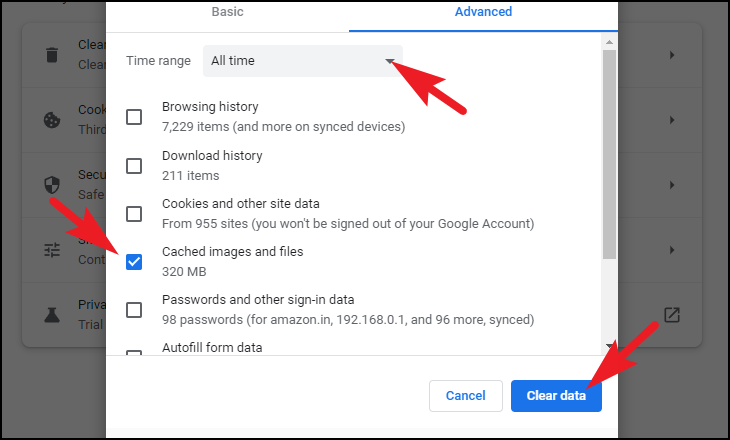
Clear Cache from Mozilla Firefox
There might be a couple of extra steps and the process being a tab bit different from the other two browsers, however, it is still very straightforward and simple to follow.
To do so, first, head to the Start Menu and type Firefox in the menu to perform a search for it. Then, from the search results, click on the ‘Firefox’ tile to open the app.
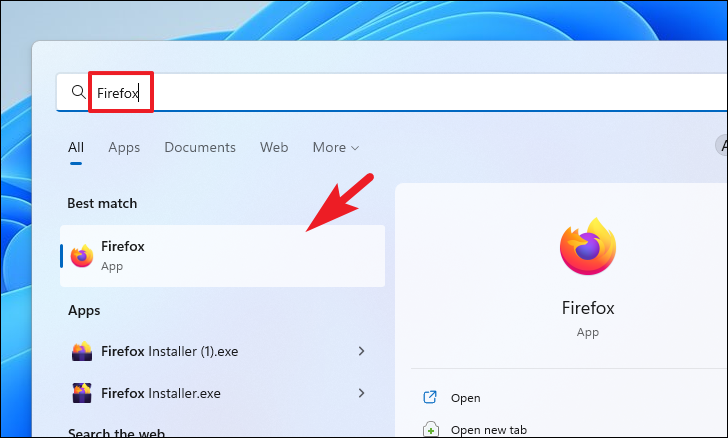
After that, from the Firefox window, click on the ‘hamburger icon’ present at the top right corner of the window to reveal the overflow menu. After that, locate and click on the ‘History’ option from the menu to expand the section.
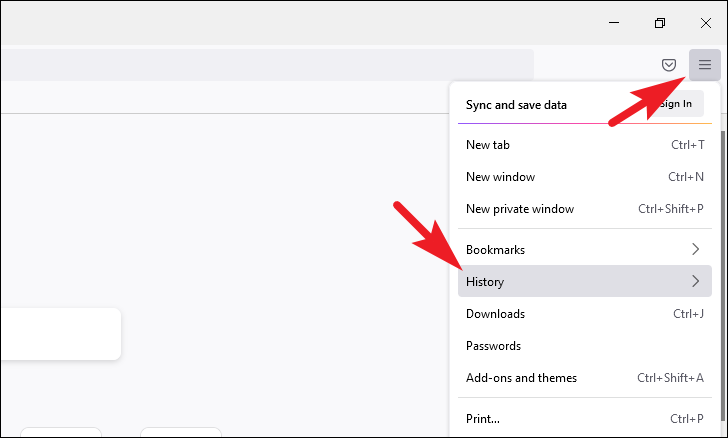
Then, from the expanded section of the overflow menu, locate and click on the ‘Clear recent history’ option to proceed. This will open an overlay window on your screen.
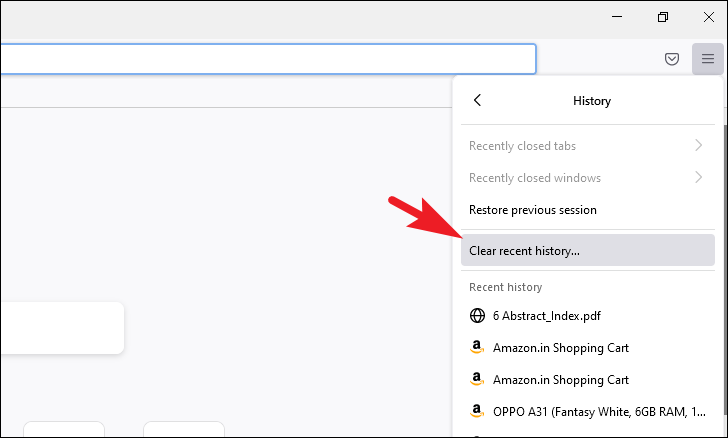
Now, from the overlay window, first, click on the dropdown menu present in the top section and select the ‘Everything’ option. After that, click on the checkbox preceding the ‘Cache’ option. Also, deselect any other item by clicking on the checkbox preceding the listing if needed. Finally, click on the ‘OK’ button to clear all the cache from Mozilla Firefox.
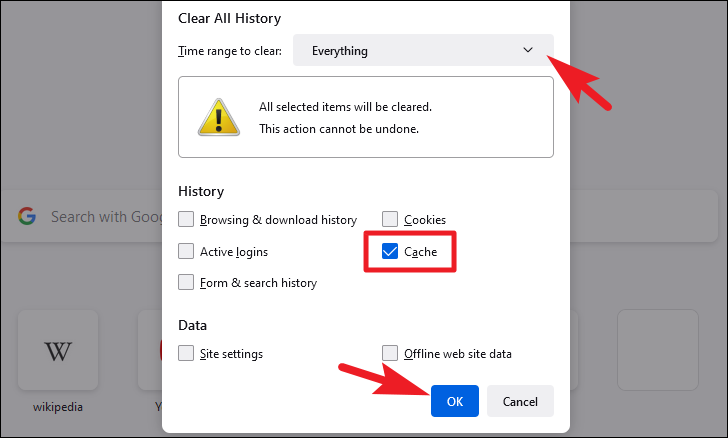
5. Free up Space by Uninstalling Optional Features
Windows 11 allows you to download and install many optional features that may be helpful for time being or just a one-off requirement. However, since they are downloaded and installed separately on your computer, they also occupy storage that is worth claiming back if you are not using them anymore. Moreover, the process is simple and straightforward with you having the option of them installing them once again should you ever feel the need for them.
To do so, first, head to the Start Menu and click on the ‘Settings’ icon tile menu present under the ‘Pinned apps’ section to continue. Otherwise, type Settings in the menu to perform a search for it. Alternatively, you can also press Windows+I keys together on your keyboard to open the app on your device.
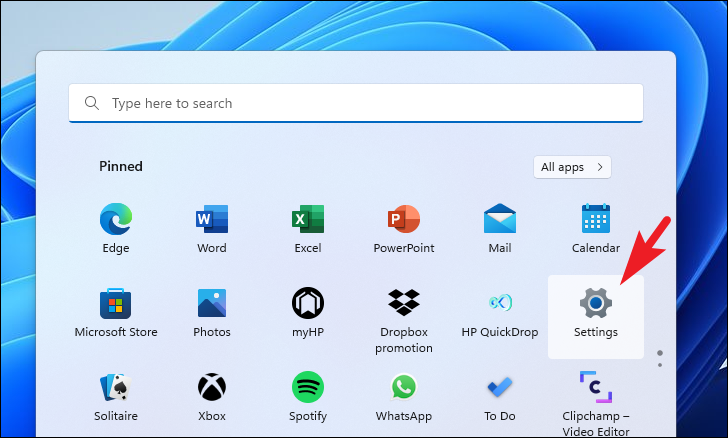
Next, on the Settings window, click on the ‘Apps’ tab present on the left sidebar to proceed.
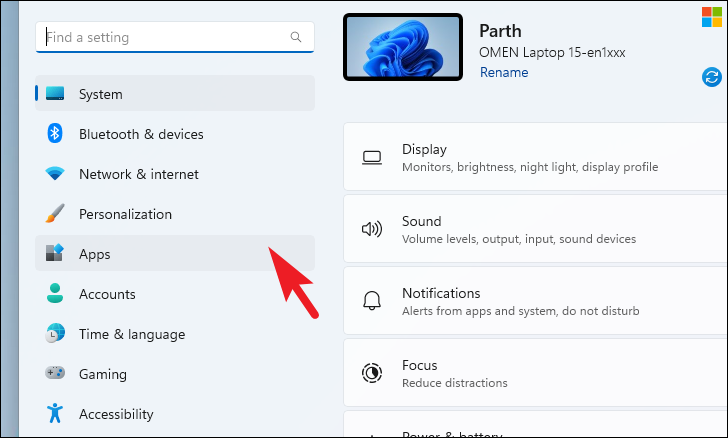
Then, from the right section of the window, locate and click on the ‘Optional features’ tile to continue.

Now, on the next screen, you will have the complete list of optional features that have been added to the device. Then, click on the drop-down menu followed by the ‘Sort by’ option present under the ‘Installed features’ section to reveal an overflow menu, and click on the ‘Install size’ option to sort the list in descending order of size.
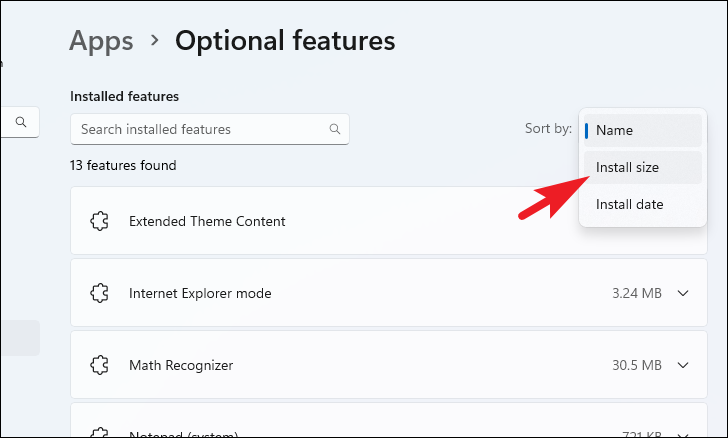
After that, view the list and decide which optional feature you wish to remove. Once decided, click on the individual optional feature tile to expand it and then click on the ‘Uninstall’ button present in the bottom right corner of the tile to uninstall the feature.
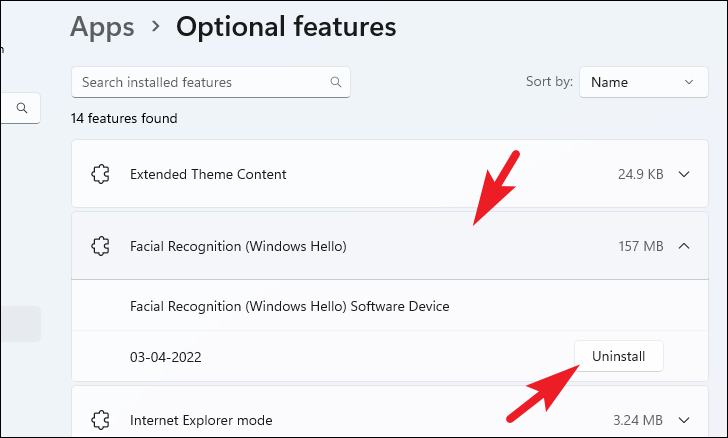
You might receive a prompt to restart your computer once you have uninstalled the feature, click on the ‘Restart now’ to restart your computer immediately. Otherwise, click on the ‘Restart later’ to restart the device at your convenience.

In case you wish to remove more than one Optional feature, repeat the above steps to completely remove it from your system.
6. Delete Unused Languages to Clear Memory
Windows 11 supports multiple languages, however, they do occupy secondary storage on your PC. Hence, if you do not tend to use them, deleting them would be a wise decision to claim back your storage space.
To do so, first, head to the Start Menu and click on the ‘Settings’ icon tile present under the ‘Pinned apps’ section to continue. Otherwise, type Settings in the menu to perform a search for it. Alternatively, press the Windows+I keys together on your keyboard to open the app.
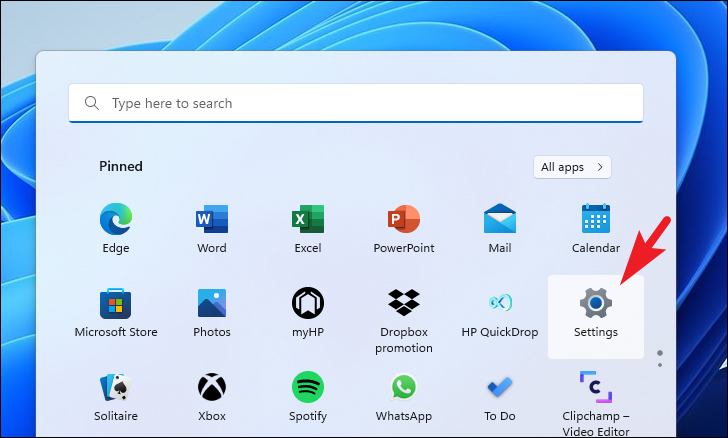
Next, from the Settings window, click on the ‘Time & language’ tab present on the left sidebar of the window to proceed.

After that, from the right section of the window, click on the ‘Language & region’ tile to continue.
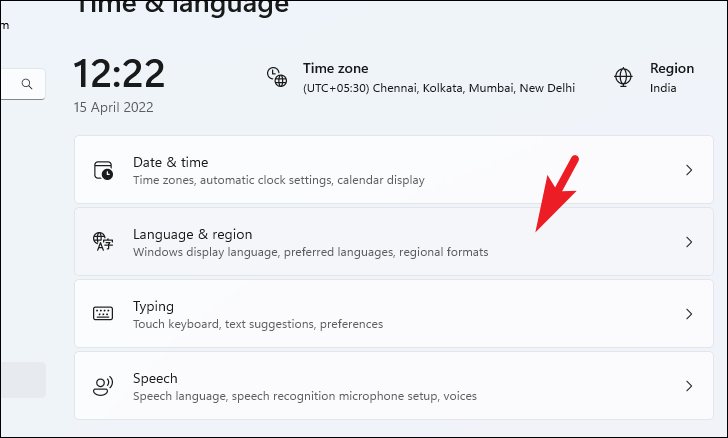
Then, on the next screen, locate the installed languages under the ‘Language’ section. After that, click on the ‘ellipsis’ icon present on the far right edge of each individual tile to reveal the overflow menu. Next, click on the ‘Remove’ button present on the overflow menu to remove the language.

In case you have multiple languages installed on your system, repeat the aforementioned steps to remove the language.
7. Free Up Space by Tweaking Search Index and Rebuilding Search Database
If you have a lot of files on your computer, excluding non-essential directories and rebuilding the search database can significantly impact the storage situation on your device positively.
To do so, first, head to the Start Menu and click on the ‘Settings’ icon tile present under the ‘Pinned apps’ section to continue. Otherwise, type Settings in the menu to perform a search for it. Alternatively, press the Windows+I keys together on your keyboard to open the app.
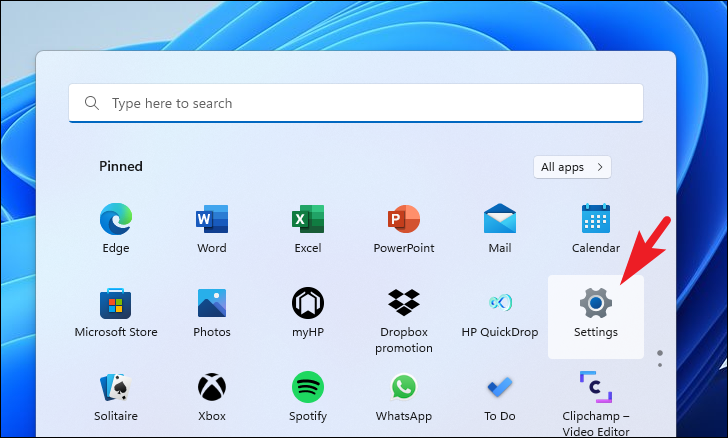
Then, on the Settings window, from the left sidebar, click on the ‘Privacy & security’ tab to proceed.
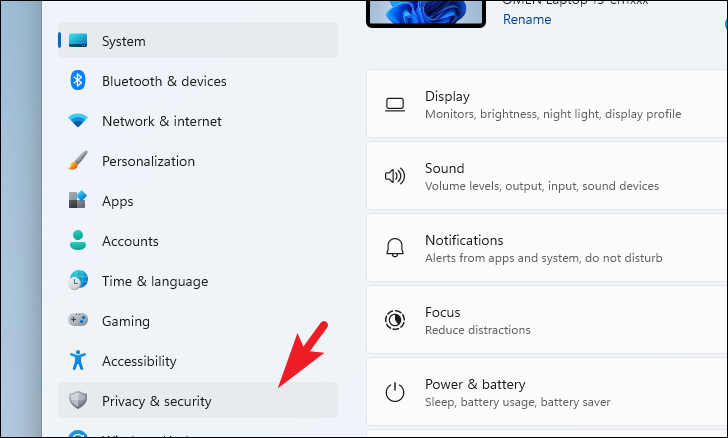
After that, from the right section of the page scroll down to locate and click on the ‘Searching Windows’ tile to proceed.
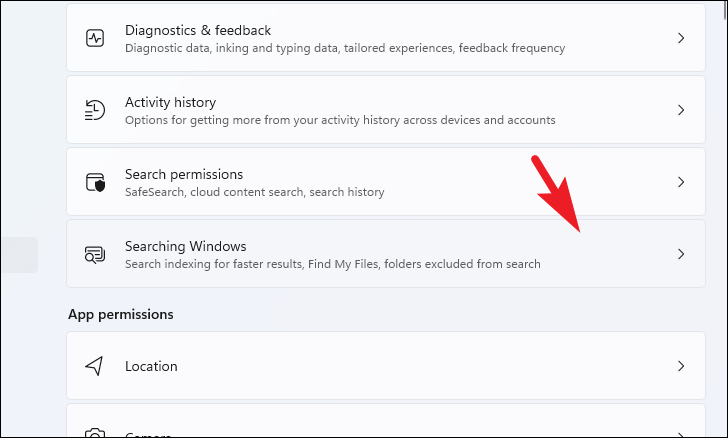
Now, on the ‘Searching Windows’ page locate and click on the ‘Advanced indexing options’ tile present under the ‘Related settings’ section to proceed. This will open a separate window on your screen.
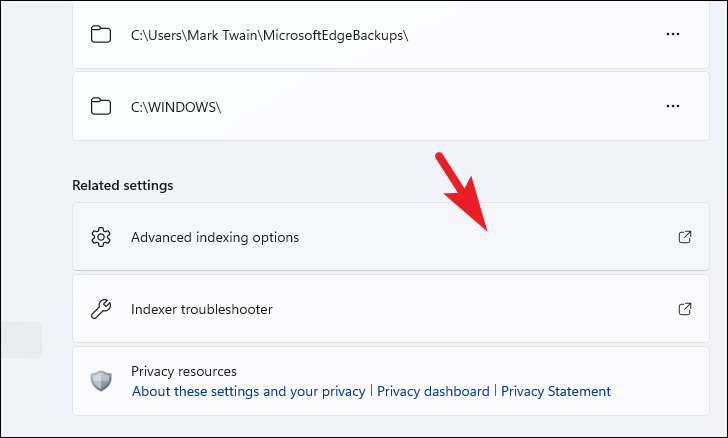
Then, from the ‘Indexing Options’ window, click on the ‘Modify’ button present in the bottom left corner of the window to continue. This will again open a separate window on your screen.
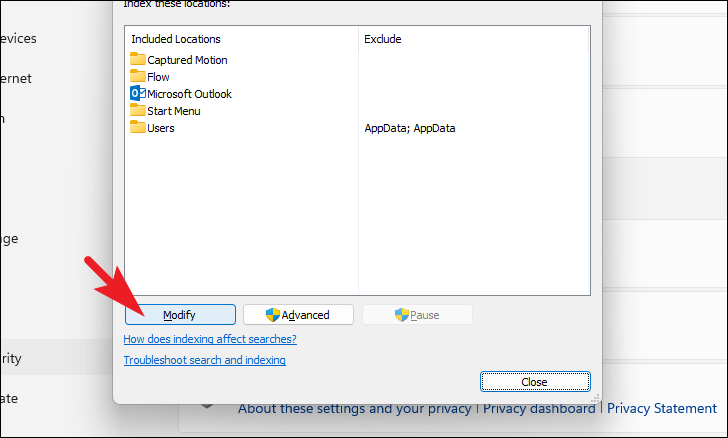
After that, from the separately opened window, click on the ‘Show all locations’ button present at the bottom left corner to proceed.
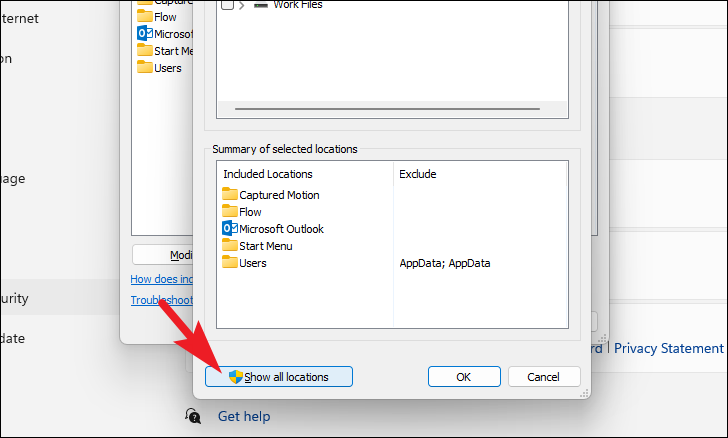
Then, under the ‘Change selected location’ section click on the checkbox preceding each listing item to deselect it. Do keep in mind the location you deselect will be no longer searchable from the Start Menu and you will have to locate the files by manually heading into the directory.
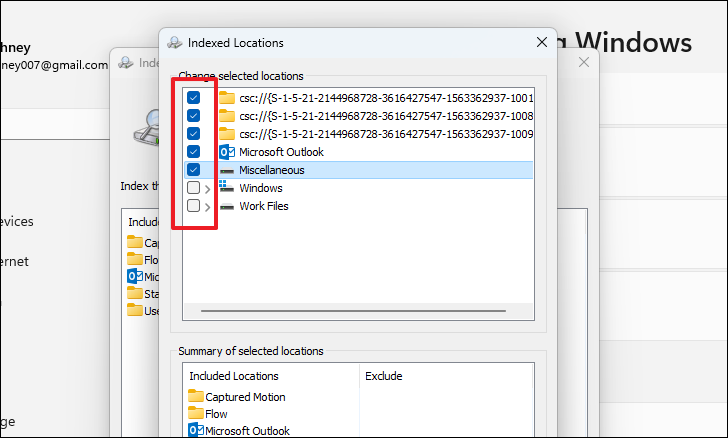
Once selected, click on the ‘OK’ button to apply and close the window.

Now, click on the ‘Advanced’ button present in the bottom right corner of the ‘Indexing Options’ window to proceed. This will open a separate window on your screen.
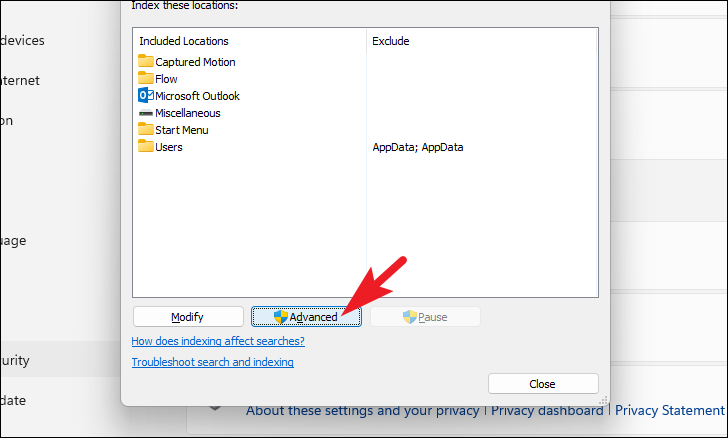
Now, from the separately opened window, locate the ‘Troubleshooting’ section and click on the ‘Rebuild’ button present under it to rebuild the search index on your device.
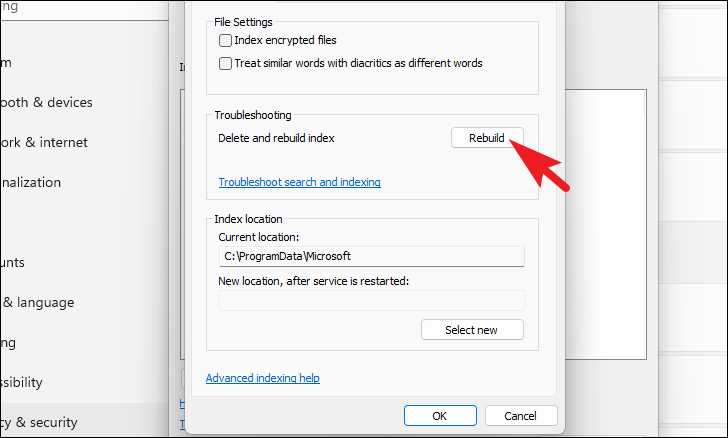
8. Use Storage Sense To Cleanup Memory Automatically
If you do not wish to do the manual labor every time you wish to clear some memory from your system to maintain your PC’s peak performance; enabling Storage Sense on your Windows 11 PC could prove to be a very smart decision.
Basically, Storage Sense automatically cleans up your storage drives when your PC is running low on space, moreover, it can also clean up temporary system files and app files. Moreover, you can also set a schedule to run the Storage Sense periodically on your Windows 11 PC. However, before you can set a schedule, you would first need to enable it on your device.
To enable the Storage Sense, head to the Start Menu and click on the ‘Settings’ tile present under the ‘Pinned apps’ section. Otherwise, you can also type Settings into the menu to perform a search for it.

After that, on the ‘Settings’ window, make sure you have selected the ‘System’ tab present on the left sidebar of the window to continue.
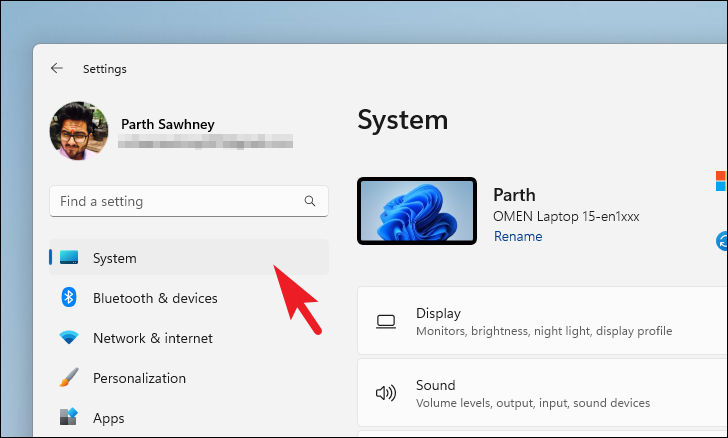
Then, from the right section of the window, locate and click on the ‘Storage’ tile to proceed.
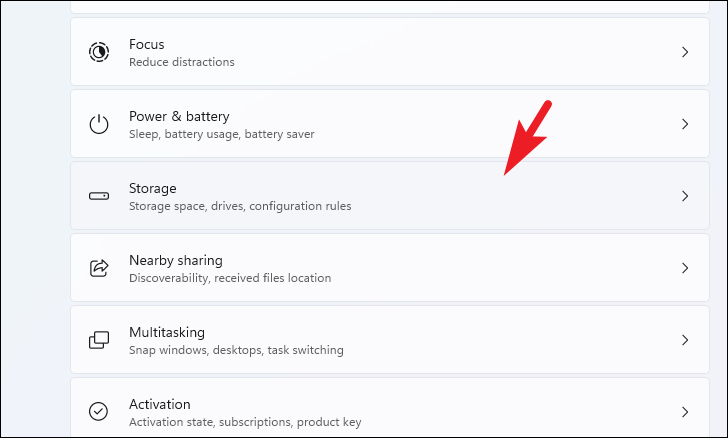
On the next screen, locate the ‘Storage management’ section and click on the toggle switch present on the far right edge of the tile to bring it to the ‘On’ position. Now, if you wish to tweak the Storage Sense settings, click on the tile to proceed.

Then, on the next screen, click on the checkbox preceding the single option present under the ‘Clean up temporary files’ section to clean up temporary system files and app files automatically.

Next, if you wish to create a periodic schedule for Storage Sense, head to the ‘Configure cleanup schedules’ section. Then, click on the drop-down menu present under the ‘Run Storage Sense’ option.
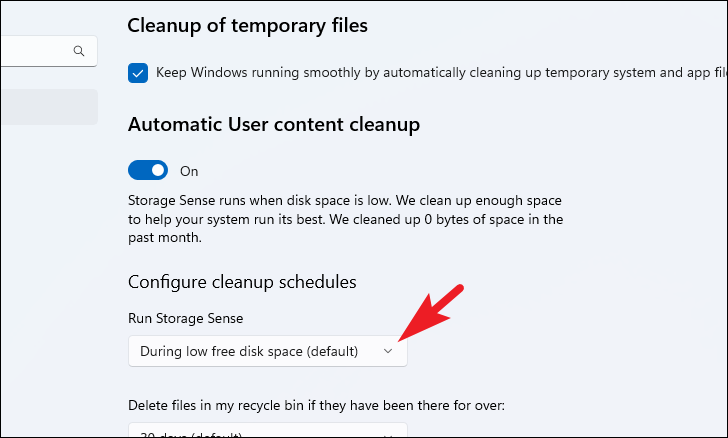
After that, click to select a preferred frequency. If you are constantly storing heaps of data and are always low on storage memory, choosing the ‘Weekly’ frequency would be recommended.
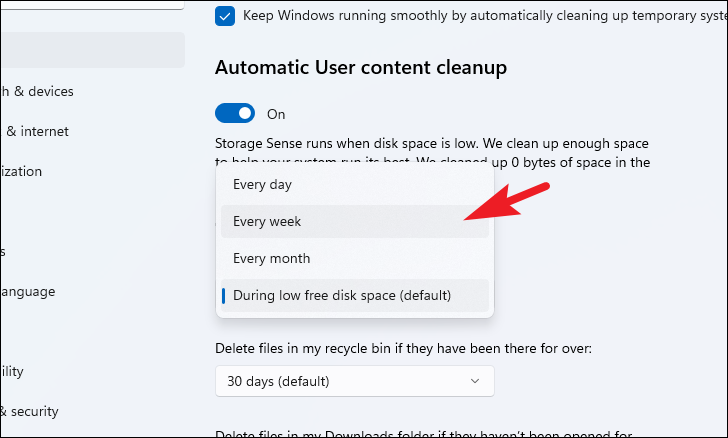
Next, click on the drop-down menu available under the ‘Delete my files in recycle bin if they have been there for over’ option and select a period of days you are comfortable with to permanently delete your files from the system.
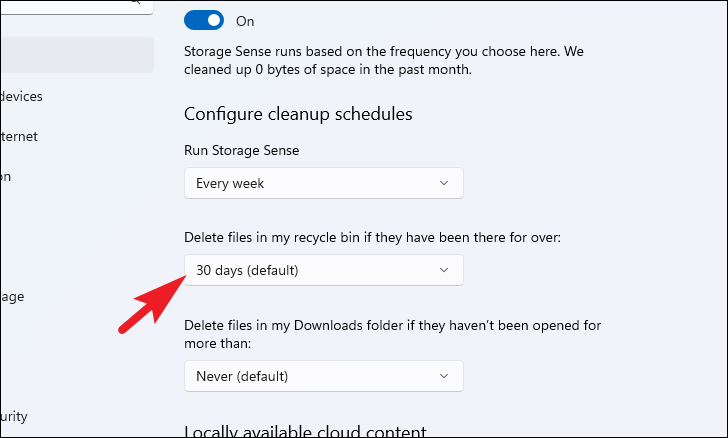
Now, if you wish to delete files in your ‘Downloads’ folder that you have not opened for quite some time, click on the drop-down menu present under the ‘Delete files in my Downloads folder if they haven’t been opened for more than’ option.
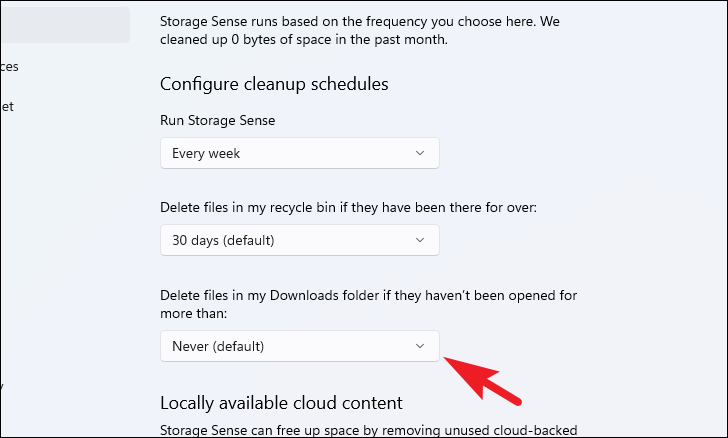
Then, click to choose the number of days you are comfortable with deleting the downloaded files.

Once you have configured the settings according to your preference, click on the ‘Run Storage Sense now’ button present at the bottom of the page to run the wizard immediately to let the Storage Sense run on your computer and free up memory on your computer.
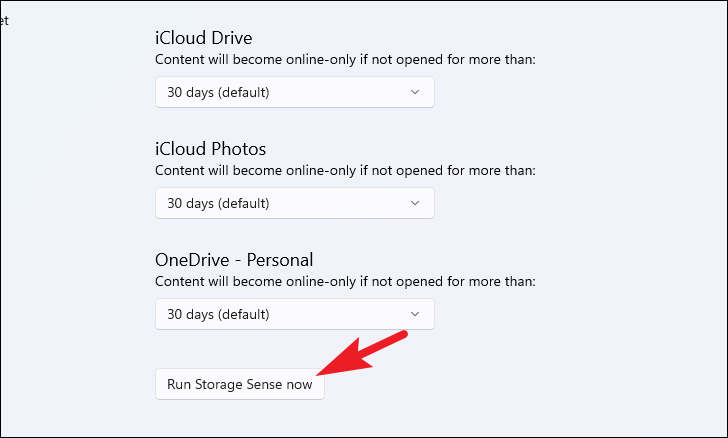
There you go folks, hopefully, this guide will help you clear memory from your system to improve the performance as well as tackle the low storage issue on your Windows 11 device.








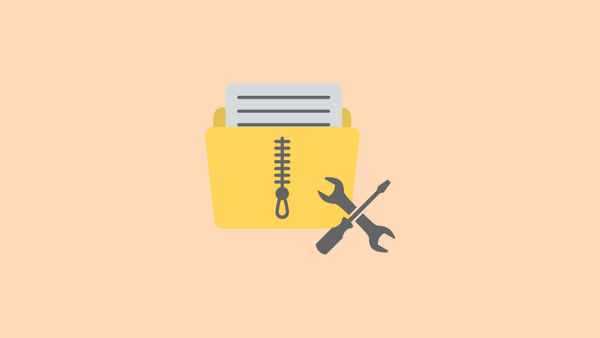


Member discussion